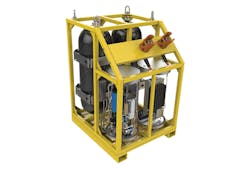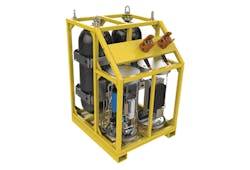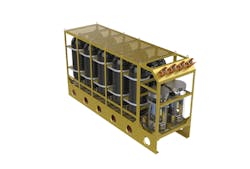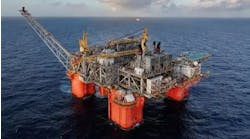Teledyne Energy Systems has developed an underwater charging station, with the aim of enabling persistent AUV operations, without needing a crew nearby to retrieve or redeploy the underwater vehicles, or a tether to supply power from above the water.
The first half of the system, the Teledyne Subsea Power Node, acts as the energy supply, using electrodialysis reversal (EDR) hydrogen fuel cells to generate 8 kW of power per cell stack, with gaseous H₂ as fuel and O₂ as reactant, which are stored in adjacent canisters. The current size of the systems can store 100 kWh, and to be released next year is a system that can store 600 kWh of energy.
ABOVE: The Teledyne Subsea Power Node acts as the energy supply using electrodialysis reversal hydrogen fuel cells.
BELOW: The Subsea Energy Node is being designed to store 600 kWh of energy.
By 2021, the technology is expected to scale to 20 MW/hrs of energy. To communicate data on critical parameters such as charge and health, Teledyne Benthos acoustic modems are integrated into the Nodes, which transmit up to 15.36 kbps of information over 9-27 kHz frequency bands to transducers 6 km away. Fuel and O₂ are delivered via Teledyne ODI’s ‘Wet Mate’ connectors to the second half of the system, which is the charging dock.
Teledyne says that its proven proton exchange membrane (PEM) fuel cell technology provides long life (>10,000 hrs.). The stack design is specifically tailored for operation with pure oxygen and includes design aspects generated through years of experience with this technology. The fuel cell system features an integrated balance-of-plant with ejector driven reactant (EDR) technology for reactant recirculation. The balance-of-plant allows the fuel cell stack to be fed reactants in a “dead-ended” configuration maximizing energy delivery.
The fuel cell system is reactant storage agnostic. Reactants can be supplied via compressed, cryogenic, or solid-state reactant storage systems. The Subsea Power Node is equipped with a compressed-gas reactant storage system. This storage system is at a technology readiness level (TRL) of 9 and is commercially refillable.
The system was recently demonstrated in naval training exercises at ANTX 2018, in 14 ft of water from a Rhode Island dock powering an ROV performing ship hull inspections and with a commercial oil and gas customer in August 2018. Teledyne says that it expects to field a 1,000 m depth-rated version in 2019, and achieve 6,000 m (full ocean depth) in late 2021. •





